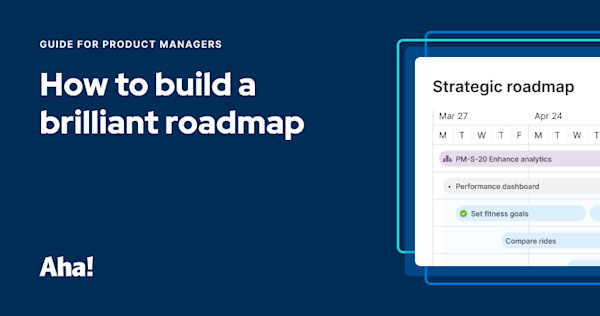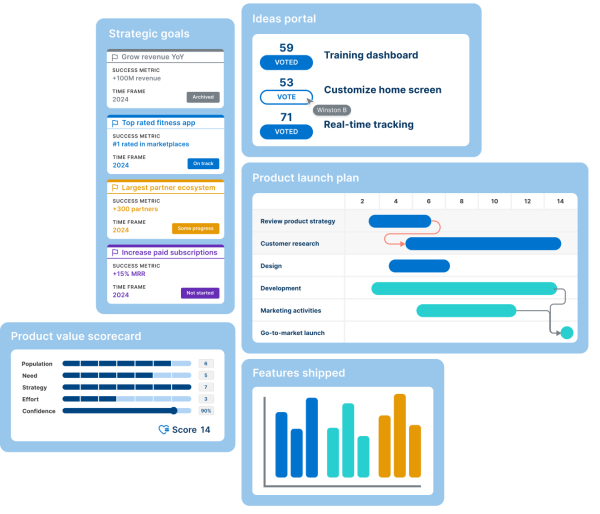What is a strategic roadmap?
Last updated: January 2025
A strategic (or strategy) roadmap is a visual plan for how you will accomplish your goals in a given time frame. It highlights prioritized work, general or specific dates, and key efforts, helping everyone see how the work supports long-term objectives. You can create an overarching strategy roadmap that illuminates your company's broad strategic vision or create a more focused strategic roadmap for a single product.
Building and sharing a strategy roadmap clarifies what the you are working toward. It is an excellent tool for aligning teams around shared objectives because it gives valuable context about how efforts tie to impact. Everyone can make the connection between how their daily, weekly, and monthly work supports the broader business or product goals.
Create and share beautiful strategy roadmaps — try Aha! Roadmaps today.
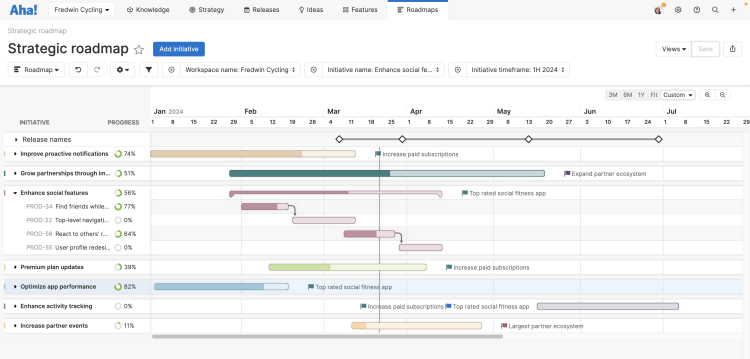
See goals, initiatives, and supporting work on a strategy roadmap in Aha! Roadmaps.
This guide will be useful whether you are building a strategy roadmap for a business or a product. Feel free to jump ahead to any section in the guide:
What should a strategic roadmap include?
If you are a product manager, you might be thinking about all the roadmaps you have built throughout your career. You might even be thinking, "Every roadmap is strategic. What is so different about a strategy roadmap?" Valid and astute! All roadmaps should be strategic and rooted in the goals and initiatives you are aiming for as you complete your work.
Many of us think of roadmaps as related to a specific effort — building a new product, delivering an important release, or collecting upcoming features. Instead of zooming in on the details of the work (like a release roadmap or features roadmap), a strategy roadmap is broad. It shows strategic areas of investment and major efforts.
But it should still convey a lot of important information about the company or product direction. A strategic roadmap should include the following:
Timeline for completion
Building one for a software product? Consider adding:
Epics or main areas of investment needed to achieve the initiatives
Assigned groups for each body of work
This is a good time to differentiate between two types of strategy roadmaps: a company's strategic roadmap (or business roadmap) and a product strategy roadmap.
1. Company strategic roadmap (sometimes called a business roadmap):
Communicates the organization's vision. For example, a company strategy roadmap could include time-bound goals, such as reaching a specific revenue target or growing the business by a certain percentage by the end of the year. It could also show the major areas of investment from cross-functional teams such as product, engineering, marketing, and customer support.
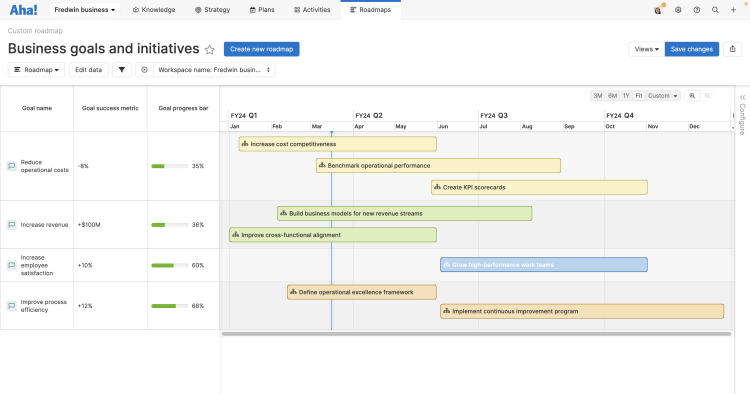
Visualize how the company is tracking against goals on a business strategy roadmap in Aha! Roadmaps.
2. Product strategy roadmap:
Conveys the product vision, which connects to and supports the larger company vision and goals. A product strategy roadmap also includes time-bound product goals, such as gaining a certain number of new customers or free trial signups each quarter. The roadmap will highlight the product initiatives (or themes of work) that product and engineering are responsible for. See the image at the top of this guide for an example.
Related:
4 big benefits of a strategy roadmap
It takes deep thought and deliberate planning to move from where you are now to where you want to be. A strategy roadmap helps, showing how you plan to achieve your vision. It is a powerful tool for communicating your desired destination, rallying the entire team around the "why" behind their work, and guiding priorities.
Here is a quick primer on the difference between vision, strategy, and a roadmap:
Vision: Establishes where you want to go and why it matters
Strategy: Captures the goals, initiatives, and approach for achieving the vision
Roadmap: Visualizes how you will achieve the strategy along with a time frame for completion
A strategy roadmap for a company or product anchors your team. You can use these visual tools to help inform prioritization decisions about what work to pursue next, postpone, or say "no" to. Only invest in the efforts that will bring you closer to your goals and initiatives.
Four big benefits of a strategy roadmap include:
Alignment: Unites everyone around shared objectives
Clarity: Declares what the organization or product team is striving toward
Focus: Orients the team around what you will accomplish and how you will deliver value
Inspiration: Motivates teammates to achieve and excites people about what is coming
And here is a nugget worth noting: Strategy roadmaps are typically internal documents. That said, some companies choose to share high-level roadmap views with various external groups. These might be customers, investors, shareholders, or partners.
For example, many companies have contractual agreements with customers. With a customer-facing strategy roadmap, you can show general time frames for when the team plans to work toward certain efforts or deliverables. Public or venture-backed companies might also create external strategy roadmaps to give context around what shareholders or investors can expect. Typically, these are even more high-level — showing only select areas of investment and general dates. (This is when it is handy to have roadmapping software that allows you to use external release dates.)
When to create a strategy roadmap
Setting a bold strategy takes time and careful consideration. Building new things is exciting, and it can be tempting to bypass strategy and jump right into making your business or product roadmap. But if your roadmap is not rooted in strategy, it will end up as a collection of random efforts or loosely related features that might not deliver real value. Instead, tie your work to a strong anchor: your strategy roadmap.
This is why company leaders typically create a strategy roadmap early, after founding a new business, coming up with a new offering, or deciding to expand into a major new market. Similarly, a strategy roadmap for a product also comes early in the product development process. Usually, company or product leaders will build it after the company and product strategy is defined, but before creating more detailed plans (such as release or features roadmaps).
For existing companies and products, you will likely make or update the strategy roadmap on a set cadence — either annually or in line with your organization's strategic planning cycle. Our team follows our own product development framework, which calls for roadmap sharing on a monthly basis. Regardless of cadence, the important thing is that you regularly revisit this roadmap. Why? Here are a few key reasons:
Business needs shift.
Customer preferences evolve.
Market shifts are constant.
Adjust your strategy (and matching strategic roadmap) to keep pace with change.
Related:
How to build a strategy roadmap
Ready to create your own strategy roadmap? If you are new to the process, it can certainly feel daunting. This is why many companies and teams use purpose-built roadmapping software like Aha! Roadmaps. You can set strategy, link features to goals and initiatives, and create and share a variety of roadmap types with both internal and external audiences.
Here's a brief five-step overview on getting started in our software. (First, you will want to open a free trial account.)
Build your initiatives: Visit the Strategy tab in Aha! Roadmaps and navigate to Imperatives. Here, capture your goals and initiatives for each level you would like — such as the company, platform, or product level. If you are defining product-level initiatives, you can map them to the overall company strategy, too.
Link initiatives to goals: Once you have defined your company or product goals, select the corresponding goal (or goals) that each initiative supports. Depending on the level of specificity you want to show on your strategy roadmap, you could also build out epics or releases that will support the goals.
Adjust the time frame: Navigate to Roadmaps, then Strategy to see your strategy roadmap visualization. Aha! Roadmaps automatically populates your data — goals, initiatives, epics, releases, and more — into the roadmap view. Drag and drop each initiative to update its time frame, adjusting the start date and end date. At the top of the roadmap, you can also control the schedule you want to display: three months, six months, one year, or a custom option.
Customize your roadmap: You can show progress toward goals with shaded bars, sort initiatives (by workspace, start or end date, rank, status, assignee, or name), or hide releases for an even higher-level view. You can also color bars by status, assignee, type, initiative, or release.
Share widely: When you are happy with your strategy roadmap, you can share it in a variety of ways. Add it to a whiteboard, presentation, or dashboard, or export it as a PDF or PNG image. This makes your roadmap accessible to leadership, the product team, other groups in the organization, customers, and more.
Related:
Strategy roadmap templates
We showed examples from Aha! Roadmaps, which is the best way to build strategic roadmaps that illustrate exactly how your areas of investment will help you reach business or product goals. But some teams might want to sketch out their strategic direction on a whiteboard first.
That is why we built simple roadmap templates. Use these to craft documents, design stunning whiteboards, and share your direction with teammates. The best part? You can convert the details on your whiteboard directly to real work in Aha! Roadmaps — no need to duplicate data.
To get started quickly, take a look at our library of guided templates or dive into the strategy roadmap template below. This template makes it easy to visualize and share your high-level plans in a flash. Fill in your details and customize the template to display exactly the information your team needs.
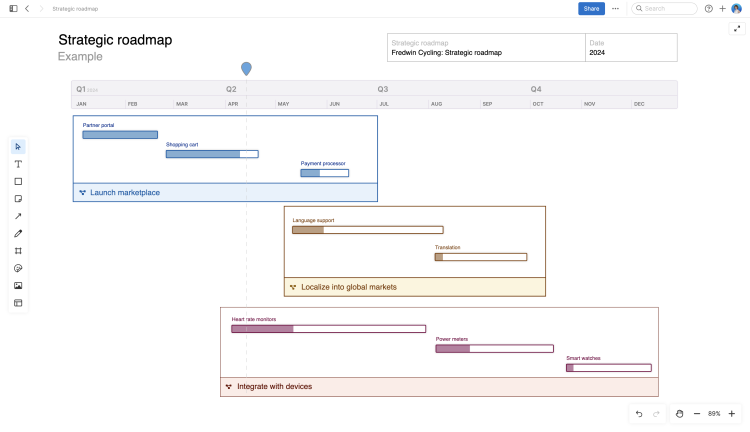
A strong strategy roadmap can transform the way the team approaches its work — inspiring everyone with a clear company or product direction. Use your strategy roadmap to inspire meaningful conversations about what you will achieve and why it matters. With a goal-first mindset, you can accomplish great things together and make a real impact on customers and the business.
